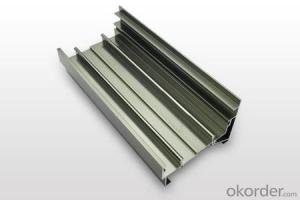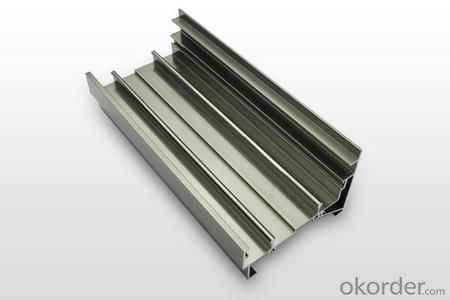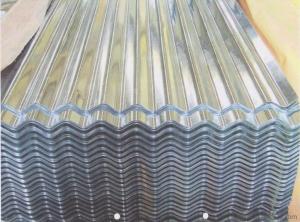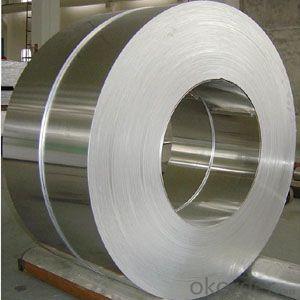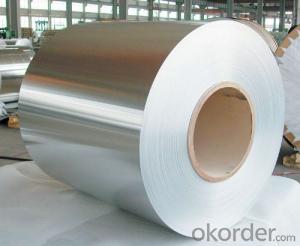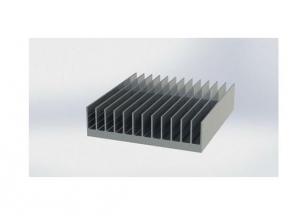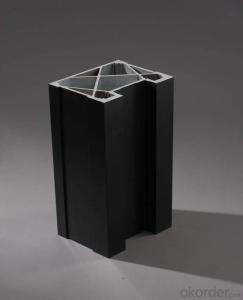Aluminum for Any Use Profile
- Loading Port:
- China Main Port
- Payment Terms:
- TT OR LC
- Min Order Qty:
- -
- Supply Capability:
- -
OKorder Service Pledge
OKorder Financial Service
You Might Also Like
Aluminium alloys with a wide range of properties are used in engineering structures. Alloy systems are classified by a number system (ANSI) or by names indicating their main alloying constituents (DIN and ISO).
The strength and durability of aluminium alloys vary widely, not only as a result of the components of the specific alloy, but also as a result of heat treatments and manufacturing processes. A lack of knowledge of these aspects has from time to time led to improperly designed structures and gained aluminium a bad reputation.
One important structural limitation of aluminium alloys is their fatigue strength. Unlike steels, aluminium alloys have no well-defined fatigue limit, meaning that fatigue failure eventually occurs, under even very small cyclic loadings. This implies that engineers must assess these loads and design for a fixed life rather than an infinite life.
Another important property of aluminium alloys is their sensitivity to heat. Workshop procedures involving heating are complicated by the fact that aluminium, unlike steel, melts without first glowing red. Forming operations where a blow torch is used therefore require some expertise, since no visual signs reveal how close the material is to melting. Aluminium alloys, like all structural alloys, also are subject to internal stresses following heating operations such as welding and casting. The problem with aluminium alloys in this regard is their low melting point, which make them more susceptible to distortions from thermally induced stress relief. Controlled stress relief can be done during manufacturing by heat-treating the parts in an oven, followed by gradual cooling—in effect annealing the stresses.
The low melting point of aluminium alloys has not precluded their use in rocketry; even for use in constructing combustion chambers where gases can reach 3500 K. The Agena upper stage engine used a regeneratively cooled aluminium design for some parts of the nozzle, including the thermally critical throat region.
Another alloy of some value is aluminium bronze (Cu-Al alloy).
Aluminium foil acts as a total barrier to light and oxygen (which cause fats to oxidise or become rancid), odours and flavours, moistness, and germs, it is used broadly in food and pharmaceutical packaging. The purpose of aluminium is to make long-life packs (aseptic processing|aseptic packaging) for drinks and dairy goods, which allows storing without refrigeration. Aluminium foil containers and trays are used to bake pies and to pack takeaway meals, ready snacks and long life pet foods.
Aluminium foil is widely sold into the consumer market, often in rolls of 500 mm (20 in) width and several metres in length.It is used for wrapping food in order to preserve it, for example, when storing leftover food in a refrigerator (where it serves the additional purpose of preventing odour exchange), when taking sandwiches on a journey, or when selling some kinds of take-away or fast food. Tex-Mex restaurants in the United States, for example, typically provide take-away burritos wrapped in aluminium foil.
Aluminium foils thicker than 25 μm (1 mil) are impermeable to oxygen and water. Foils thinner than this become slightly permeable due to minute pinholes caused by the production process.
- Q: I am not doing as much as some people to go green, but I'm tryingMy mother, who went through the Great Depression, was a saver and a re-userI am notHowever, I have become more conscious of the need to conserveToday I washed out a zip-lock baggie that had contained cookiesThought I would re-use it! What do you re-use?
- when the water tastes like sea water it is salty enough, about 1-1 1/2 cup per gallon add whole black pepper and a can of beer or a bottle of hard cideras or air drying, that is only important if you are smoking it, air dryimg creates a sticky surface for the smoke to stick to
- Q: Is it safe or practical to use aluminum foil for making soup?
- <p>While it is possible to use aluminum foil to cover a pot while making soup, it is not recommended for direct contact with the soup itself. Aluminum foil can react with acidic foods, potentially leaching aluminum into the food, which may have health implications. It's safer to use a lid made of glass, ceramic, or stainless steel. Aluminum foil can be used for other purposes in cooking, such as lining baking sheets or wrapping food for indirect cooking, but for making soup, it's best to avoid direct contact with the food to prevent any contamination.</p>
- Q: Can aluminum coils be used in the production of kitchen utensils?
- Yes, aluminum coils can be used in the production of kitchen utensils. Aluminum is a popular choice for kitchen utensils due to its lightweight, durable, and heat-conducting properties. Aluminum coils can be easily shaped and molded into various utensil designs such as pots, pans, baking trays, and even cutlery. Additionally, aluminum is resistant to corrosion, making it suitable for contact with food and liquids. It is important to note that aluminum utensils may require a non-stick coating or a protective layer to prevent the reaction between aluminum and certain acidic or alkaline foods. Overall, aluminum coils are widely used in the production of kitchen utensils due to their versatility and practicality.
- Q: since i was worrying if this type of metal wire will have nasty effect on my sculpture while it's baked.i went to Home Depot and they don't have armature or aluminum wires so the guy gave me galvanized wire.is this type of metal wire ok?
- what did the package of Sculpy say about what type of wire to use? use what it said and nothing else Home Depot does have aluminum wire - it comes on a roll and they will measure it out for you and charge by the length.you may have asked for the wrong thing try cutting a very small piece of it and put it in a small piece of clay ( a 1 ball) and put it in ovensee what happensdid you tell him it would go into the oven? doesnt Sculpy have a website you can go to to ask questions about their product?
- Q: I read a snippet somewhere about putting organic materials in a bowl and wrapping that bowl with aluminum foil then firing itI was wondering if this technique would actually create a cool texture on the pot or if it would have a cool effect on the glazeMy teacher won't let me try random experiments so I was hoping someone could point me in the direction of a website that would help or tell me their experience.Our kiln is electric and fires up to cone sixThanks!!
- Just a thoughtStudy a catenary arch, cut small blocks with the angles needed to fit one to another to make that arch, drill a hole through the center of each block, string them together with a piece of string long enough to let the pieces be loose and fall unless the string is tightened to form the arch.
- Q: Heard that silver polish can ruin the silver What do I do?
- Generally, most household products do what they're supposed to if you follow the instructionsSilver polish contains an abrasive, and if you use too much, press very hard, or leave the paste in the crevices, you do run the risk of taking the silver off the base metalIf you don't want to run that risk, here are some things you can do: If you're trying to remove a specific stain or blotch, a small amount of white toothpaste (not gel, not children's sugary kind) on a washcloth will often do it If you're trying to take tarnish off a piece (let's say a sugar bowl, for this example) follow this method: Take a large, ordinary kitchen pot with a metal interior (no ceramic lining or enamel, please) and fill it with water, high enough that the bowl can be completely submergedBring the water to a boil, and stir in a quarter cup of regular baking sodaTake a piece of aluminum foil, a foot square or so, ball it up, and drop it into the waterThen, gently place your sugar bowl in the waterWatch carefully, because you don't want to ding the bowl against the side of the potIn a few minutes, you will see the tarnish cling to the foil and away from the bowl Using tongs, gently remove the bowl from the boiling water when you are satisfied that the tarnish has been removedThe bowl will be extremely hot to the touchIf you have more items, repeat the process, refreshing the baking soda each time An advantage to this method is that only the metal oxide, and not the clean, pretty silver underneath, is removed and therefore preserves the item longer than an abrasive methodThe disadvantage, though, is that it exposes the item to heat, so if there's been a repair you run the risk of ungluing the repairAlso, remember that silver is soft and becomes softer when exposed to high heat, so be very gentle with your silver piece to avoid denting or disfigurement Good luck.
- Q: Ok so whenever I make fried chicken the coating never turns out like it does at a restaurantIn particular I LOVE the popeye's chicken strips.the spicy kindHow are those made, if you know, otherwise just a way to make good coating like they have would be cool also! Thanks.
- INGREDIENTS: 3 cups self-rising flour 1 cup cornstarch 3 tablespoons seasoning salt 2 tablespoons paprika 1 teaspoon baking soda 1 (.7 ounce) package dry Italian-style salad dressing mix 1 (1 ounce) package dry onion soup mix 1 packet dry spaghetti sauce mix 3 tablespoons white sugar 3 cups crushed cornflakes cereal 2 eggs, beaten 1/4 cup cold water 2 cups oil for frying 1 (4 pound) whole chicken, cut into pieces -DIRECTIONS: In a shallow dish or bowl mix together the flour, cornstarch, seasoning salt, paprika, baking soda, dressing mix, soup mix, spaghetti sauce mix and sugarPlace cereal crumbs in another shallow dish or bowl, and mix together eggs and water in a third shallow dish or bowlHeat oil (1 inch deep) in a large skillet over medium high heatPreheat oven to 350 degrees F (175 degrees C)Dip chicken pieces into dry coating mix, egg/water mixture, cereal crumbs, briefly into dry mix once more, then drop into hot oil skin side downBrown for 3 to 4 minutes, then brown other side of each piecePlace browned chicken pieces in a 9x13 inch baking dish, skin side up, and cover dish with aluminum foil leaving one side open for escaping steamBake at 350 degrees F (175 degrees C) for 35 to 45 minutes, or until chicken is cooked through and tender and juices run clearRemove cover and bake another 5 minutes to let coating become crisp; serve.
- Q: its for my daughters school and i have not got a clue where to start its to be made from household bits and bobs
- Doll-sized? If so, start with a wire coat hanger and bend it into the shape of a stick figureBoth ends should meet at the torso, so they can be covered with clothing, Make the clothing out of cloth scrapsUse brown paper (like from a grocery sack) for some of the armor, and aluminum foil-covered paper for the metal partsHave fun!
- Q: does anyone know where you can buy Otis Spunkmeyer oven paper?it comes in a 1000 sheet pack, I have only a small amount of this paper left.thanks.glenn
- It is called Parchment Paper and is available from any restaurant supply house in 1000 sheet pack for around $25.00 OR you can buy a roll for a $3.00 in the grocery store in the aluminum foil or baking section.
- Q: Lets say you started with a round bar and bored it outWhich aluminium would give stronger walls, less likely to dent?
- Grenade launcherrrr!!!
Send your message to us
Aluminum for Any Use Profile
- Loading Port:
- China Main Port
- Payment Terms:
- TT OR LC
- Min Order Qty:
- -
- Supply Capability:
- -
OKorder Service Pledge
OKorder Financial Service
Similar products
Hot products
Hot Searches
Related keywords
